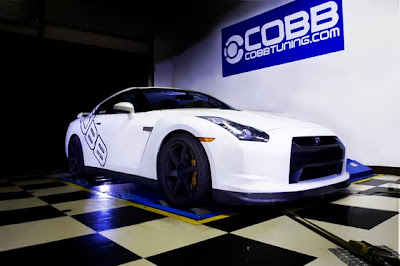


The graph below shows the stochiometry of E85 (lamda) is similar for pump and E85 but the volume of fuel required for E85 is much higher by proportion (Air to fuel ratio). Despite these limitation of E85 we wanted to tune our GTR to utilize this fuel. Together, the lower cost, higher octane, and higher overall power potential are simply too much to resist. Furthermore, because E85 has not been used in the new GTR platform I simply couldn’t resist the technical challenge.

Because a stock GTR can use nearly 100% of its available injector capacity on pump fuel the first step in using E85 is to replace the stock injectors with larger units. We chose to use Deatschwerks 800cc injectors. These are ~30% larger than stock and should be able to provide the additional fuel volume needed for E85. The injectors were installed and the car tuned on pump fuel:
Stock - completely stock calibration with 92 octane pump fuel - BLUE
Stage 2 800cc - COBB catless midpipe, COBB prototype cat back exhaust, stock intake, stock fuel pump. - RED

We then drained the tank and refilled with E85 full. I adjusted the calibration with COBB AccessTUNER Pro software and prepared to run the car. The first few runs were done at low boost and all was well. The calibration was then adjusted for higher boost and we attempted a full run. I aborted the run because the motor went progressively leaner at RPMs and fuel demand increased.This increasing lean condition clearly points out a lack of fuel delivery. Because our injectors are mathematically ideal for ~30% higher flow it’s clear that the stock fuel pumps simply cannot keep up with higher duty cycle with 800cc injectors.To combat the lack of fuel we installed two walbro 255s in the place of the stock fuel pumps. The installation took about 4 hours total as the stock in tank fuel surge tank needed heavy but straightforward modification. With new fuel pumps installed we went back to the dyno with high hopes of sufficient fuel delivery. The results are presented in the graph below:
Stock 2009 GTR - 92 octane - BLUE
Stage 2 800cc - COBB catless midpipe, COBB prototype cat back exhaust, stock intake, stock fuel pump, 800cc Deatschwerks injectors - RED
Stage 2 800cc + E85 - COBB catless midpipe, COBB prototype cat back exhaust, stock intake, Twin walbro 255 fuel pumps, 800cc Deatschwerks injectors - GREEN

This E85 Stage 2 configuration is now the highest HP and torque stock turbo car tuned on our Mustang dyno. When the weather clears here in the pacific northwest we’ll find some dry test roads and report V-box data. We’re also planning to rent a local drag strip for development and testing so ETs and trap speeds are coming. As a next step we plan to install some custom intakes. If our early observations are correct this car will make more than 600 whp on stock turbo’s with E85…. all while retaining the factory downpipes.

No comments:
Post a Comment